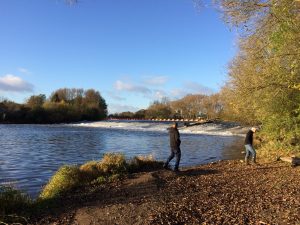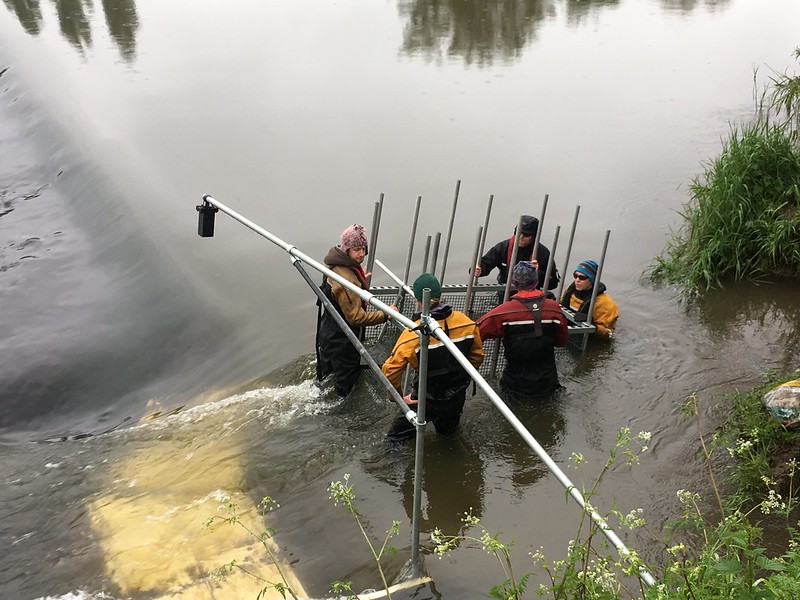
Scientific monitoring is a vital part of the Unlocking the Severn project. It gives us an indication of the population size and how this is changing over time. We are also gaining fascinating insights into the behaviour of individual twaite shad on the River Severn. We have learnt how barriers in the river, such as weirs, affect the migration of different fish species. Perhaps most importantly for Unlocking the Severn, the science helps us make sure that our project will be successful at enabling the twaite shad, and other endangered fish species, to reach their historic spawning grounds.
Our scientific monitoring reaches peak activity during the shad run. This is what we call the period of time when the twaite shad are migrating up the River Severn to spawn. The shad run sometimes starts as early as mid-April and extends to early-June. Most shad are on the river for about a month, and the majority of their migration takes place in May. They have therefore earned the nickname the May fish.
Find out about the different types of scientific monitoring we conduct during the shad run below.
Monitoring Techniques
Counting the shad at Upper Lode Weir
One of the first monitoring techniques that takes place in the spring is in-person observations, counting shad. At Upper Lode Weir in Tewkesbury, Gloucestershire, shad are able to pass over the weir via a notch next to the riverbank. We use this site to count the fish seen passing through the notch, as a way of estimating the migrating population.
Every year we recruit citizen scientists to help us with this task. They record real-time data for us, and then their timed sample observations are fed into a mathematical model that estimates the total number of migrating shad passing Upper Lode Weir. We compare data between years to provide trends in the migrating population on the Severn over time.
Shad counting takes place from mid-April and runs through to early June. We recruit Migration Monitoring Volunteers in April. If you would like to find out more or get involved, see our webpage HERE.
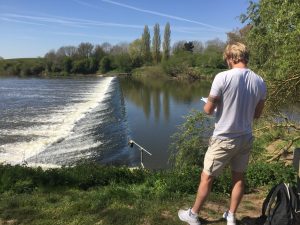
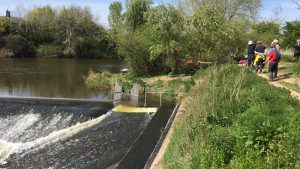
Volunteers counting the shad at Upper Lode Weir in Tewkesbury
Tagging
Tagging is a useful method to track the behaviour of individual shad during their migration. The data we receive shows us the where and when specific shad pass different receivers at locations up and down the river.
First, we catch shad to tag by setting a large trap at the top of Upper Lode weir. Highly trained researchers, operating under licence from the Home Office then insert a small tag inside suitable shad. The shad is then released without harm back into the water to continue its journey.
We use two different types of tag during the shad run…
Acoustic tagging
Acoustic tags are used to track the journey of individual shad from the Bristol Channel through the River Severn. The tags transmit an acoustic signal every minute or so and an array of acoustic receivers are placed at key locations along the riverbank and throughout the Severn estuary. When the shad swims past, the receiver, it records a unique ‘ping’ from the tag and the time that shad passed by is recorded. This data is combined to produce a chart of the shad’s migration through the River Severn.
The battery in the tags lasts for 3 years, so we can record the migration journey of individual shad for up to 3 years. Shad are repeat spawners; they return to freshwater to spawn each year for up to 5 years. So, a tagged fish will give us up to 3 years of data covering 3 spawning seasons. There is a 60% survival rate between spawning seasons so for every 100 shad we tag in year 1, we expect to track 60 shad of these shad which return in year 2, and 36 which return in year 3. Mortality at sea is normal between years as these fish undertake their annual growth and spawning migrations.
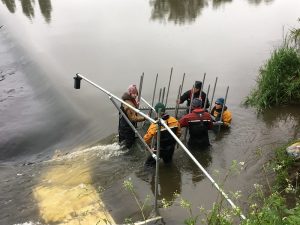
Scientists installing the traps at Upper Lode Weir.
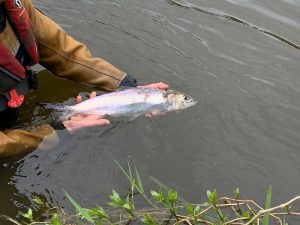
Scientist releasing a twaite shad back into the River Severn, after tagging.
We began tagging shad in 2017, before fish pass construction had begun. This was the first ever acoustic tracking of shad in the UK, and it took place with 25 tagged fish (we have tagged over 250 to date). The tracking results confirmed that the migration route of shad was blocked by both Diglis Weir (River Severn) and Powick Weir (River Teme). However, we also discovered the huge distances that some fish travelled during their time in river, many making multiple trips up and downstream before ultimately returning to the sea.
This year, 2022, is the final year we currently have funding for shad tagging. We aim to use up the remaining 158 tags to get a good indication of shad migration in the first year that the river is ‘unlocked’. These tags will continue providing data for up to 3 years, so it will be interesting to see how the shad’s migration changes now that they have access to the upper reaches of the river. We expect to see a slow return to the upper Severn, relying on pioneer shad on their first spawning journey, to reach further than those fish who have previously spawned lower down the river.
PIT tags
Passive Integrated Transponders (PIT tags) are tracking tags which provide a location when fish swim close to a special antenna, or PIT tag loop. The shad are required to swim much closer to these compared to the acoustic receivers. We have therefore placed PIT tag loops at either end of Diglis fish pass. We knew from past acoustic data that, prior to the fish passes, had reached Diglis weir and did not progress any further. It is therefore important to know two things:
1 – Shad are able to find the entrance of the fish pass
2 – Shad are able to swim through the fish pass
If both of these are true, then we can have every confidence that shad will be able to pass through all four fish passes and ultimately recolonise the river up to the Welsh borders.
Alongside the shad with acoustic tags, we make sure to have a selection of shad with both acoustic and PIT tags.
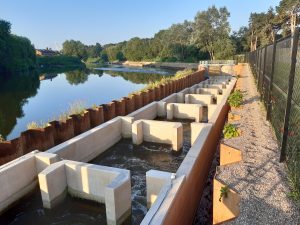
Diglis Fish Pass in Worcester.
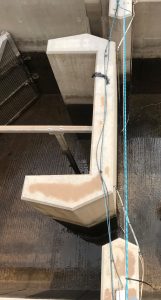
Bird’s eye view of the PIT tag loop running across one of the concrete C-sections in Diglis fish pass.
Footage from Diglis underwater viewing gallery
As well as providing a brilliant engagement tool, allowing members of the public and school groups to see wild fish up close, our fish window at Diglis is a very important addition to our scientific monitoring. We have scientific cameras set up in the underwater viewing gallery, which record footage of different species using the fish pass. One camera is motion-detecting, triggered by the movement of even small minnow past the window. The other camera is continuously recording and provides a good back up in case the former is compromised.

Looking down into Diglis underwater viewing gallery. Photography: Barbara Evripidou.
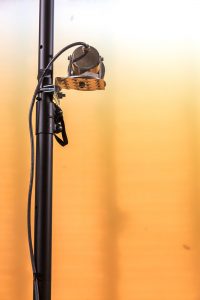
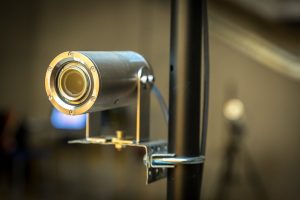
Scientific monitoring cameras are used to record footage of the fish swimming past #DiglisFishWindow. Photography: Barbara Evripidou.
The deep vertical slot fish passes that are suitable for the twaite shad, also benefit a host of other River Severn wildlife. So far, Diglis fish pass has provided an alternative route past the weir for 23 different fish species.
You can see footage of some of these different species using the pass HERE.
2022 is the first year we will have the viewing window and monitoring cameras in place when the whole River Severn is unlocked by all four fish passes between Worcester and Stourport – for the first time in nearly 180 years – or 35 generations of shad! We are looking forward to getting data and footage of the different species using Diglis fish pass for the whole spring season. In particular we are keen to count the number of shad passing Diglis in what we hope will be more normal river conditions than we experienced last year when the river ran very high and cold through most of May.
Shad spawning monitoring
Shad make a very distinctive splashing sound when spawning. It is important for our project to gather information as to where shad spawning is taking place. This will be even more useful this year, in 2022, now that all four passes are complete. We hope that, in the future, shad populations will reach their historic spawning grounds, in gravel beds on the unlocked reaches of the river through North Worcestershire and Shropshire.
There are two ways in which we can listen out for spawning taking place.
Night-time spawning walks
During May, once we know the shad are on the river and water temperatures are 16 degrees and above, members of the Unlocking the Severn team and some very committed volunteers head out at night to listen for spawning. Peak spawning time is around 2am, so this is certainly a late-night monitoring activity!
AudioMoth data
We also use acoustic monitoring devices to listen out for spawning activity. AudioMoths are relatively low-cost sound recording devices, used to monitor wildlife. A sound frequency chart of the audio recordings can be viewed and an audio signature that matches the distinctive splashing sound of shad spawning can be identified. This helps us spot these events in many hundreds of hours of continuous audio recording!
Finding the right position for AudioMoths is tricky. They need to be close enough to the river to detect the sound of spawning, but also in a sheltered location to avoid picking up too much background noise.
eDNA
eDNA is a method of testing an environment for genetic material. eDNA is really helpful for Unlocking the Severn as we’re not limited to only the small sample of shad that we can catch and tag. Every shad releases DNA into the environment that can be picked up via eDNA sampling. This helps us identify how far up the river shad (amongst other species) have managed to migrate at any particular point in time. eDNA gives a good indication of the geographic range of different fish species on the river and we can show the positive impact of fish passes on how far fish can migrate.
This year’s sampling is taking place in conjunction with Natural England. Sampling for the spring migration will be taking place on two days: 1 in mid-May and 1 in late-may/early June. The plan is to sample 7 sites, 5 along the Severn and 2 on the Teme.
The technique involves collecting 3 water samples from each site. The water sample is collected by our team from a bridge above the water. The water samples are then pushed through a syringe with a filter in it that collects the eDNA. These collected samples are then put on ice to ensure the DNA is not destroyed, and transported to a lab for analysis. The DNA is then extracted from the samples by centrifuge (this is a piece of scientific equipment which spins a sample very quickly in a circle to separate the layers of material within the sample). Metabarcoding analysis is then performed in the lab. This analysis looks at the number of species that are present in the environment and compares the collected eDNA samples to a database of DNA to confirm which species were present in the sample.


